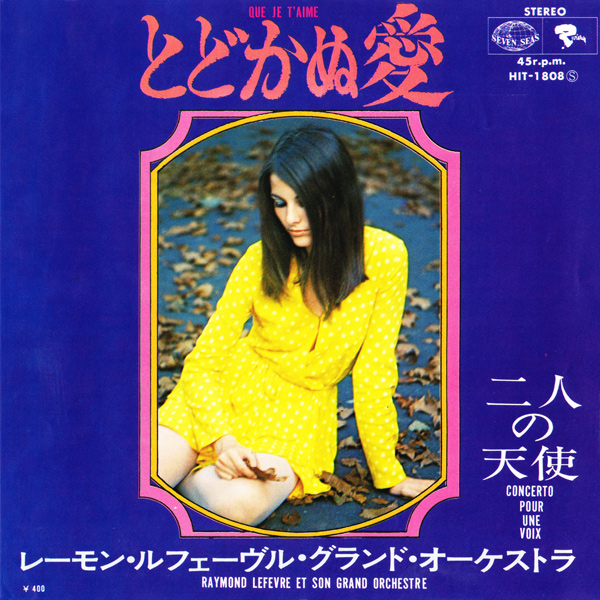45 R.P.M.: QUE JE T'AIME

HIT-1808 S, Seven Seas, King Record Co. Ltd., Japan. '70-9. Recorded by Riviera (France).
- Que je t'aime (J. Renard, G. Thibaut)
- Concerto pour une Voix (Saint-Preux)
SLEEVE NOTES:
It is often said these days that the 1970s was the era of feeling, and I think that this is a clear indication of the major issues facing society in the 1970s, such as the revival of human nature and the longing for nature. The recent attempts to close the streets to pedestrians on Sundays by removing cars from the main streets of many cities can be seen as a symbol of this feeling era. The catch phrase of the 60's, "Oh my goodness," has disappeared and the word "beautiful" has become a popular phrase. The music that best fits this "beautiful" era is the easy listening sound. Beautiful melodies and gorgeous sounds can trigger the development of various imaginative worlds for listeners, and by immersing oneself in the sounds, one can enjoy a sense of freedom from modern life.
The Raymond Lefebvre Grand Orchestra is a perfect example of this kind of easy listening. Lefebvre is one of the leading figures in the French pop music world, and is now popular all over the world along with Paul Mauriat and Franck Pourcel. Mixing a superb contemporary sensibility with the French chanson tradition, Lefèvre is quick to incorporate contemporary pop trends into his sound, appealing to both young and old fans alike. In particular, his innovative arrangements and excellent musicianship are a big step forward from the straightforward sound of mood music, creating a sophisticated sound that can be enjoyed not only as background music to create a mood, but also as a pleasure to listen to.
Lefebvre has already had a wide range of hits, from beautiful romantic pieces such as "Queen of Sheba" and "Adagio Cardinal" to rock-style beat numbers, but the contrast between the beautiful string melodies and the large rhythm section is truly modern. The contrast between the beautiful string melodies and the large rhythm section is very modern. Lefèvre's career has already been extensively described, but here are some of his main points: He was originally a classical musician, and majored in flute at the Conservatoire. In 1956, he started his own group, and in the meantime, he arranged the backing orchestra for Dalida's "Ciao Ciao Bumpina," and has been in this world ever since. In 1968, his orchestra's rendition of "Âme câline" became popular in the American hit parade circuit and made him a worldwide star.
Que je t'aime:
This romantic ballad is perfect for the autumn season when you are lost in thought. It was a hit song by Johnny Halliday in 1969. Lefebvre uses strings and brass to express how sad it is to love someone in a modern way. The sound of the harpsichord is used to great effect and the feeling is beautiful, very French pop.
Concerto pour une Voix:
In the European pop music scene, there have been a number of recent hits based on classical themes. The "Fifth Symphony" (Beethoven's Fifth Symphony) by Ekseption and "El Himno de la Alegría" (Beethoven's Ninth Symphony) by Miguel Rios are representative of this trend. It was a hit. Lefebvre's baroque organ introduction and the woodwind solo in the introduction create a baroque atmosphere, and the romantic melody in the minor register is very moving.
Shigeki Ichi Kato
Recorded by RIVIERA, France
Note: Translation made by online translator.
